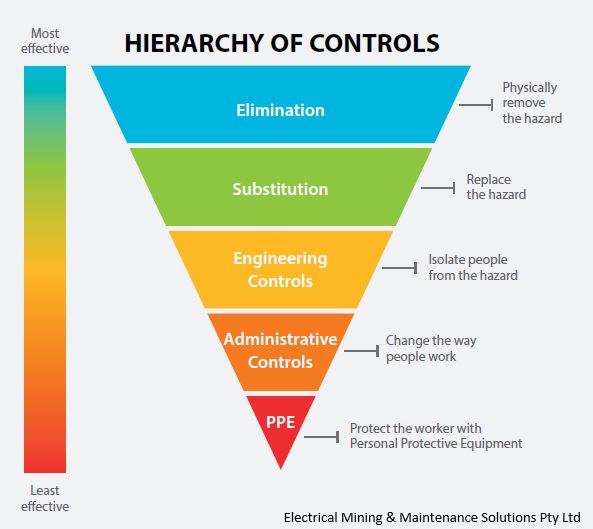Task Observation – Hierarchy of controls
Aim
This Code of Conduct applies to all employees as a tool to help reduce risk in the work environment by introducing a hierarchy of control to determine how to implement practical and effective risk management that can be used in the day to day operations.
Purpose
The purpose of Task Observation is an aid in reducing risk to workers by introducing planning, identification of hazards, assessment and the control of risk.
- Prevent and reduce the number and severity of workplace injuries, illnesses and associated costs
- Promote and improve worker health, wellbeing and capacity to work, and
- help to foster innovation and improve quality and productivity of work.
An essential outcome of risk assessment is identifying and prioritising measures to control the risks. The findings of the risk assessment be used to formalise an action plan for controlling future risks.
Expectations
All employees are expected to observe the highest standards of safety in their daily work environment to safeguard against risk to themselves, their workmates and the people around them.
Behaviour
A safe and healthy workplace does not happen by chance or guesswork. Employees should be familiar with hierarchy of controls to use in their everyday work environment to help them plan, identify hazards, assess and control risk.
You have to think about what could go wrong at your workplace and what the consequences could be. Then you must do whatever you can (in other words, whatever is ‘reasonably practicable’) to eliminate or minimise health and safety risks arising from your business or undertaking.
This process is known as risk management and involves the four steps set out in this Code
- Identify hazards—find out what could cause harm.
- Assess risks, if necessary—understand the nature of the harm that could be caused by the hazard, how serious the harm could be and the likelihood of it happening. This step may not be necessary if you are dealing with a known risk with known controls.
- Control risks – implement the most effective control measure that is reasonably practicable in the circumstances and ensure it remains effective over time.
- Review hazards and control measures to ensure they are working as planned.
Hierarchy of Controls
Employees should use the hierarchy of control to determine how to implement practical and effective risk management.
The hierarchy of control includes elimination or substitution, collective control measures through engineering and work organisation, and personal protective equipment.

Elimination
Elimination is a process that eradicates the risk source – it is the most effective way to prevent risks to all workers and should always be considered when introducing a new work process, selecting new work equipment and designing the layout of the work environment.
Substitution
Substitution is a process of replacing equipment with alternatives where possible. When elimination is not possible, substitution of equipment may be the next-best alternative to protect workers from exposure to risk.
Engineering controls
Engineering controls are all about making changes to processes, machinery or equipment so that the workers are exposed to less risk. For example, using screens, barriers, enclosures and absorbent materials help to reduce workers’ exposure.
Administrative controls
Administrative controls are the way work is organised to reduce either the number of workers who are exposed or the length of time they are exposed to risk. Administrative controls should be used when it is not possible to reduce exposure through elimination, substitution or engineering control measures.
Personal protective equipment
Personal protective equipment protects the users from any adverse effect’s exposure to high levels of noise. It is the last option in the hierarchy of control and should be used as a last resort after all efforts to eliminate or reduce risk levels have been exhausted through technical and organisational means. (WHS Regulation 44: Provision to workers and use of personal protective equipment)
Reviewing control measures
Implemented control measures should be reviewed regularly and if necessary revised, to make sure they work as planned. Employers should make sure that:
- Related hazards have been identified, assessed and controlled.
- Control measures introduced are working effectively.
- Control measures introduced have not created any new problems.
- The engineering controls put in place have made the job safer.
- Safety procedures are being followed adequately.
- Training and instruction provided on how to work safely have been successful.
- Raised health and safety concerns are report promptly.
- Frequency and severity of health and safety incidents are reducing over time.
Once completed, you should consider the hazards and risks you identified and implement control measures in line with the hierarchy of control measures in order to eliminate or minimise the risks, so far as is reasonably practicable.
Keeping Records
It is essential for management and employees to keep records Emms provide a number of forms for keeping track of the planning, identification of hazards, assessment and control of risk;
- Risk Register # 41
- hazard checklists
- worksheets
- assessment tools
Consequences
Failure to follow the basic principles of Planning Identification of hazards, assessment & control of risks can lead to fines or at worst death.
Reporting
All Managers and operations coordinators are responsible for monitoring and evaluating the operation of this policy within their area of responsibility and reporting accordingly to either the EmmS Operations or Site Manager or the WHS Coordinator.
Note:
For further guidance on the risk management process review the recently developed standard AS/NZ ISO 31000:2018 Risk Management-Principle and guidelines available from Standards Australia.
